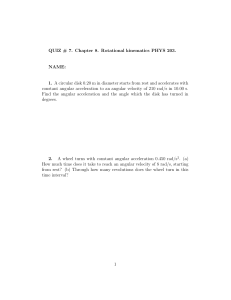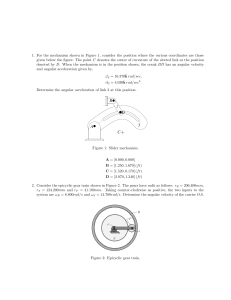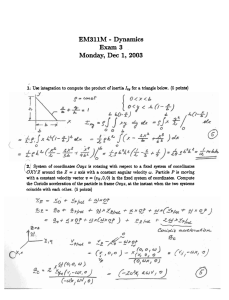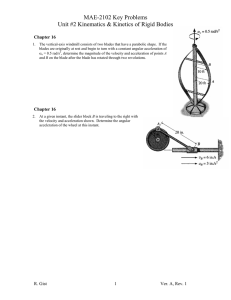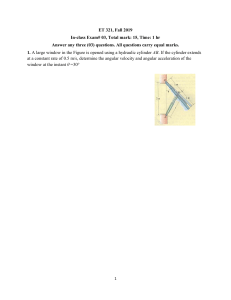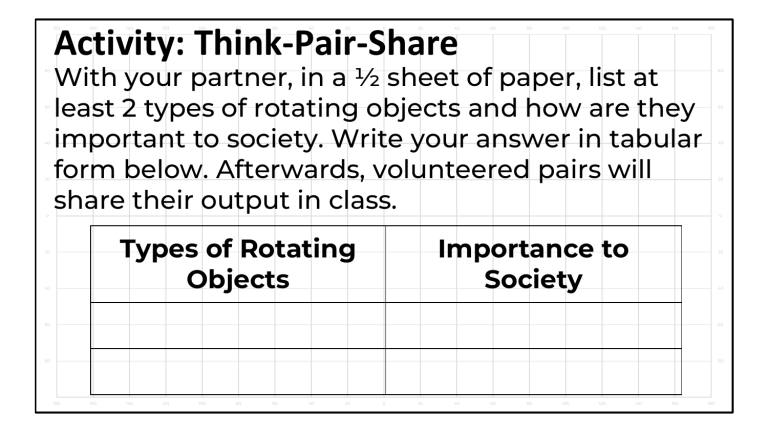
180 160 140 120 100 80 60 40 20 0 20 40 Activity: Think-Pair-Share 80 60 40 20 0 60 80 100 120 140 160 180 With your partner, in a ½ sheet of paper, list at least 2 types of rotating objects and how are they important to society. Write your answer in tabular form below. Afterwards, volunteered pairs will share their output in class. Types of Rotating Objects 20 40 80 60 40 20 0 Importance to Society 20 40 60 60 80 80 180 160 140 120 100 80 60 40 20 0 20 40 60 80 100 120 140 160 180 General Physics 1 180 160 140 120 100 80 60 40 20 0 20 40 60 80 100 120 140 160 180 80 80 60 60 Rotational Kinematics 40 20 0 20 Lesson 1 40 40 20 0 20 40 60 60 80 80 180 160 140 120 100 80 60 40 20 0 20 40 60 80 100 120 140 160 180 180 160 140 120 100 80 General Physics 1 Lesson Objectives 80 60 40 20 0 20 40 60 80 100 120 140 160 180 80 Define kinematic rotational variables 01 such as angular position, angular velocity, and angular acceleration. 02 Derive rotational kinematic equations. 60 40 20 0 20 60 40 20 0 20 Solve for the angular position, angular 03 velocity, and angular acceleration of a rotating body. 40 60 80 180 160 140 120 100 80 60 40 20 0 20 40 60 80 100 120 140 40 60 80 160 180 180 160 140 120 100 80 60 40 20 0 20 40 60 80 100 120 140 160 180 ❑ Kinematics – studies the description of motion 80 80 60 60 40 40 20 20 0 0 20 20 40 40 60 60 80 80 of objects. ❑ Rotational Kinematics –it’s all about any object that can rotate or spin. ❑ The kinematics of rotational motion describes the relationships among rotation angle (θ), angular velocity (ω), angular acceleration (α), and time (t). 180 160 140 120 100 80 60 40 20 0 20 40 60 80 100 120 140 160 180 180 160 140 120 100 80 60 40 20 0 20 40 60 80 100 120 140 160 180 Consider a thin disk of radius r spinning on its axis 80 80 ❑This disk is a real object, it has structure. ❑We call these kinds of objects rigid bodies. ❑Rigid bodies do not bend twist, or flex; for example, a billiard ball. 60 40 20 0 20 40 60 80 In the simplest kind of rotation, points on a rigid object move on circular paths around an axis of rotation. 180 160 140 120 100 80 60 40 20 0 20 40 60 80 100 120 140 160 60 40 20 0 20 40 60 80 180 180 160 140 120 100 80 60 40 20 0 20 40 60 80 100 120 140 160 180 80 80 60 60 40 40 20 20 0 0 20 20 40 40 60 60 80 80 180 160 140 120 100 80 60 40 20 0 20 40 60 80 100 120 140 160 180 180 160 140 120 100 80 60 40 20 0 20 40 60 80 100 120 140 160 180 80 80 60 60 40 40 20 20 0 0 20 20 40 40 60 60 80 80 180 160 140 120 100 80 60 40 20 0 20 40 60 80 100 120 140 160 180 180 160 140 120 100 80 60 40 20 0 20 Angular Displacement 40 60 80 100 120 140 160 180 80 80 60 60 40 40 20 20 0 0 20 20 40 40 60 60 80 80 180 160 140 120 100 80 60 40 20 0 20 40 60 80 100 120 140 160 180 180 160 140 120 100 80 60 40 20 0 20 Angular Displacement 40 60 80 100 120 140 160 180 80 80 ❑The angle of rotation, θ, is the angular displacement, measured in radians. 60 40 20 0 60 40 20 0 ❑For one complete revolution, conversion relation: 20 20 40 40 60 60 80 80 𝟐𝝅 𝒓𝒂𝒅 = 𝟑𝟔𝟎° = 𝟏 𝒓𝒆𝒗 180 160 140 120 100 80 60 40 20 0 20 40 60 80 100 120 140 160 180 180 160 140 120 100 80 60 40 20 Sample Problems 0 20 40 60 80 100 120 140 160 180 80 80 1) An object travels around a circle 10 full 60 60 turns in 2.5 seconds. Calculate (a) the angular displacement, θ, in radians. 2) A girl goes around a circular track that has a diameter of 12 m. If she runs around the entire track for a distance of 100 m, what is her angular displacement? 40 20 0 20 40 60 80 180 160 140 120 100 80 60 40 20 0 20 40 60 80 100 120 140 160 40 20 0 20 40 60 80 180 180 160 140 120 100 80 60 40 20 Sample Problems 0 20 40 60 80 100 120 140 160 180 80 80 3) Synchronous satellites are put into an orbit whose radius is 4.23×107m. If the angular separation of the two satellites is 2.00 degrees, find the arc length (in km) that separates them. 60 40 20 0 20 40 60 80 180 160 140 120 100 80 60 40 20 0 20 40 60 40 20 0 20 40 60 80 60 80 100 120 140 160 180 180 160 140 120 100 80 60 40 Angular Velocity 80 60 40 20 0 20 40 60 80 100 120 140 160 180 80 ❑ In rotational motion, angular velocity (ω) is defined as the change in angular displacement (θ) per unit of time (t). In symbol, 60 40 20 20 𝝎= 0 20 40 60 ∆𝜽 ∆𝒕 0 20 ❑ Unit is as revolution per second (rev/sec, rps), or radian per second 40 60 𝝎 = 𝟐𝝅𝒇 80 180 160 140 120 100 80 60 40 20 80 0 20 40 60 80 100 120 140 160 180 180 160 140 120 100 80 60 40 Angular Velocity 20 0 20 40 60 80 100 120 140 160 180 80 80 ❑ From linear velocity conversion, we have 60 𝝎= 40 20 𝒗𝒕 𝒓 60 𝒗𝒕 = 𝒓𝝎 OR 40 20 where: ω is the angular velocity (rad/s), 𝑣𝑡 is the tangential velocity (m/s), and r is the radius in circular path (meters). ❑ The farther away the object is from the center of rotation, the higher the tangential velocity. 0 0 20 20 40 40 60 60 80 80 180 160 140 120 100 80 60 40 20 0 20 40 60 80 100 120 140 160 180 180 160 140 120 100 80 60 40 20 0 20 40 60 80 100 120 140 160 180 80 80 60 60 40 40 20 20 0 0 20 20 40 40 60 60 80 80 180 160 140 120 100 80 60 40 20 0 20 40 60 80 100 120 140 160 180 180 160 140 120 100 80 60 40 20 Sample Problems 0 20 40 60 80 100 120 140 160 180 80 80 60 60 1) If an object travels around a circle 40 40 with an angular displacement of 70.8 radians in 3.0 seconds, what is its average angular velocity ω in (rad/s)? 20 0 20 40 20 0 20 40 60 60 80 80 180 160 140 120 100 80 60 40 20 0 20 40 60 80 100 120 140 160 180 180 160 140 120 100 80 60 40 20 Sample Problems 0 20 40 60 80 100 120 140 160 180 80 80 2) A gymnast on a 60 40 20 0 20 40 60 80 180 60 high bar swings through two revolutions in a time of 1.90 s. Find the average angular velocity (in rad/s) of the gymnast. 160 140 120 100 80 60 40 20 40 20 0 20 40 60 80 0 20 40 60 80 100 120 140 160 180 Angular Acceleration 180 160 140 120 100 80 60 40 20 0 20 40 60 80 100 120 140 160 180 ❑ Changing angular velocity means that an angular acceleration is occurring over time. 80 80 60 60 ❑ The angular acceleration, α, of a rotating object is the rate at which the angular velocity changes with respect to time. 40 40 20 20 0 0 20 20 ∆𝝎 𝝎𝒇 − 𝝎𝒊 𝜶= = ∆𝒕 𝒕𝒇 − 𝒕𝒊 40 60 40 60 ❑ Unit of measure is radian per second squared (rad/s2). 80 180 160 140 120 100 80 60 40 20 0 20 40 60 80 100 120 140 80 160 180 Angular Acceleration 180 160 140 120 100 80 60 40 20 0 20 40 60 80 100 120 140 ❑ If there is angular acceleration, there will also be tangential acceleration, since the tangential velocity is changing. 160 180 80 80 ac 60 60 40 40 20 20 𝒗𝒕 𝟐 𝜶𝒕 = 𝒓𝜶 and 𝜶𝒄 = = 𝝎𝟐 𝒓 𝒓 ❑We can find a total resultant acceleration 𝜶, since 𝒂𝒕 and 𝒂𝒄 are perpendicular, 0 0 20 20 40 40 60 60 𝑎𝑐 80 𝒂= 180 160 𝟐 𝒂𝒄 + 𝒂𝒕 140 120 100 𝟐 80 60 ∅ = 𝒕𝒂𝒏 40 20 0 −𝟏 (𝒂𝒕 /𝒂𝒄 ) 20 40 60 80 100 120 140 160 180 80 180 160 140 120 100 80 60 40 80 60 40 20 0 20 40 60 80 100 120 140 160 180 ❑ Although every particle in the object has the same angular ac acceleration, its tangential acceleration differs proportional to its distance from the axis of rotation. ❑The father away the particle is from the rotation axis, the more radial/centripetal acceleration it receives. 80 𝜶𝒕 = 𝒓𝜶 60 40 20 20 0 0 𝟐 𝒗𝒕 𝜶𝒄 = 𝒓 𝟐 𝜶𝒄 = 𝝎 𝒓 20 40 60 80 180 160 140 120 100 20 40 60 80 80 60 40 20 0 20 40 60 80 100 120 140 160 180 180 160 140 120 100 80 60 40 20 0 20 40 60 80 100 120 140 160 180 ❑Angular displacement, angular velocity, and angular acceleration are all vector quantities. 80 80 60 60 40 40 20 20 0 ❑The direction for angular velocity and angular acceleration can be determined by the right-hand rule. 0 20 20 40 40 60 60 80 80 180 160 140 120 100 80 60 40 20 0 20 40 60 80 100 120 140 160 180 Right-Hand Rule 180 80 60 40 20 0 20 40 60 80 160 140 120 100 80 60 40 20 0 20 40 60 80 100 120 140 160 180 A convenient tool in determining the direction of the angular velocity. Defining the zaxis as the axis of rotation, curl your fingers of your right hand in the direction of rotation, your thumb points in the direction of the angular velocity and acceleration. 180 160 CCW is +, while CW is – 140 120 100 80 60 40 20 0 20 40 80 60 40 20 0 20 40 60 80 60 80 100 120 140 160 180 180 160 140 120 100 80 60 40 20 Sample Problems 0 20 40 60 80 100 120 140 160 180 80 80 1) A 60 40 jet awaiting clearance for takeoff has momentarily stopped on the runway. As seen from the front of one engine, the fan blades are rotating with an angular velocity of –110 rad/s, where the negative sign indicates a clockwise rotation. As the plane takes off, the angular velocity of the blades reaches -330 rad/s in a time of 14 s. Find the angular acceleration, assuming it to be constant. 60 40 20 20 0 0 20 20 40 40 60 60 80 80 180 160 140 120 100 80 60 40 20 0 20 40 60 80 100 120 140 160 180 180 160 140 120 100 80 60 40 20 Sample Problems 0 20 40 60 80 100 120 140 160 180 2) A helicopter blade has an 80 60 40 20 0 20 40 60 80 180 angular speed of 6.50 rev/s and an angular acceleration of 1.30 rev/s2. For point 1 on the blade, find the magnitude of (a) the tangential speed, (b) the tangential acceleration, (c) centripetal acceleration, and the (d) resultant acceleration. 160 140 120 100 80 60 40 20 0 20 40 80 60 40 20 0 20 40 60 80 60 80 100 120 140 160 180 Variables for Rotational and Translational Kinematics 180 160 140 120 100 80 60 40 20 0 20 40 60 80 100 120 140 160 180 80 80 60 60 40 ❑Consider a correlation of variables below: 20 Translational d displacement v velocity acceleration 𝑎 t time 0 20 40 60 80 180 160 140 120 100 80 60 40 20 0 20 40 40 20 Rotational 𝜽 𝝎 𝜶 t 60 80 100 120 140 160 0 20 40 60 80 180 Kinematic Equations for Rotational and Translational Motion 180 80 160 60 40 20 0 20 40 60 80 180 160 140 120 100 80 60 40 Rotational (𝛼 is constant) 𝝎𝒊 + 𝝎𝒇 𝜽=( )𝒕 𝟐 𝝎𝒇 = 𝝎𝒊 + 𝜶𝒕 𝟏 𝟐 𝜽 = 𝝎𝒊 𝒕 + 𝜶𝒕 𝟐 𝝎𝒇 𝟐 = 𝝎𝒊 𝟐 + 𝟐𝜶𝜽 140 120 100 80 60 40 20 20 0 0 20 20 40 60 80 100 120 140 60 80 100 120 180 80 Translational (a is constant) 𝒗𝒊 + 𝒗𝒇 𝒅=( )𝒕 𝟐 𝒗𝒇 = 𝒗𝒊 + 𝒂𝒕 𝟏 𝟐 𝒅 = 𝒗𝒊 𝒕 + 𝒂𝒕 𝟐 𝒗𝒇 𝟐 = 𝒗𝒊 𝟐 + 𝟐𝒂𝒅 40 160 140 60 40 20 0 20 40 60 80 160 180 Tips for Problem Solving 180 160 140 120 100 80 60 40 20 0 20 40 60 80 100 120 140 160 180 80 80 ❑Similar to the techniques used in linear motion problems o With constant angular acceleration, the techniques are much like those with constant linear acceleration ❑There are some differences to keep in mind o For rotational motion, define a rotational axis ▪ The choice is arbitrary 60 60 40 40 20 20 0 0 20 20 40 40 60 60 80 80 180 160 140 120 100 80 60 40 20 0 20 40 60 80 100 120 140 160 180 Tips for Problem Solving 180 160 140 120 100 80 60 40 20 0 20 40 60 80 100 120 140 160 180 80 80 ❑There are some differences to keep in mind ▪ Once you make the choice, it must be maintained ▪ In some problems, the physical situation may suggest a natural axis o The object keeps returning to its original orientation, so you can find the number of revolutions made by the body. 60 60 40 40 20 20 0 0 20 20 40 40 60 60 80 80 180 160 140 120 100 80 60 40 20 0 20 40 60 80 100 120 140 160 180 Kinematic Equations for Rotational and Translational Motion 180 80 160 60 40 20 0 20 40 60 80 180 160 140 120 100 80 60 40 Rotational (𝛼 is constant) 𝝎𝒊 + 𝝎𝒇 𝜽=( )𝒕 𝟐 𝝎𝒇 = 𝝎𝒊 + 𝜶𝒕 𝟏 𝟐 𝜽 = 𝝎𝒊 𝒕 + 𝜶𝒕 𝟐 𝝎𝒇 𝟐 = 𝝎𝒊 𝟐 + 𝟐𝜶𝜽 140 120 100 80 60 40 20 20 0 0 20 20 40 60 80 100 120 140 60 80 100 120 180 80 Translational (a is constant) 𝒗𝒊 + 𝒗𝒇 𝒅=( )𝒕 𝟐 𝒗𝒇 = 𝒗𝒊 + 𝒂𝒕 𝟏 𝟐 𝒅 = 𝒗𝒊 𝒕 + 𝒂𝒕 𝟐 𝒗𝒇 𝟐 = 𝒗𝒊 𝟐 + 𝟐𝒂𝒅 40 160 140 60 40 20 0 20 40 60 80 160 180 180 160 140 120 100 80 60 40 20 0 20 40 60 80 100 120 140 160 Sample Problem: Blending with a Blender 180 80 80 The blades of an electric blender are whirling with an angular velocity of +375 rad/s while the “puree” button is pushed in. When the “blend” button is pressed, the blades accelerate and reach a greater angular velocity after the blades have rotated through an angular displacement of +44.0 rad (seven revolutions). The angular acceleration has a constant value of +1740 rad/s2. Find the final angular velocity of the blades. 60 60 40 40 20 20 0 0 20 20 40 40 60 60 80 80 180 160 140 120 100 80 60 40 20 0 20 40 60 80 100 120 140 160 180 180 160 140 120 100 80 Group Task 80 60 40 20 0 20 40 60 80 100 120 140 160 180 80 A wheel rotates with a constant angular acceleration of 3.5 rad/s2. If the angular speed of the wheel is 2.0 rad/s at t=0 a) through what angle does the wheel rotate between t = 0 and t = 2.0 s? Give your answer in radians and in revolutions. b)What is the angular speed of the wheel at t = 2.0 s? 60 40 20 0 20 40 60 80 180 160 140 120 100 80 60 40 20 0 20 40 60 80 100 120 140 160 60 40 20 0 20 40 60 80 180 180 160 140 120 100 80 Group Task 60 40 20 0 20 40 60 80 100 120 140 160 180 80 60 40 20 0 20 40 60 80 80 A figure skater is spinning with an angular velocity of +15 rad/s. She then comes to a stop over a brief period of time. During this time, her angular displacement is +5.1 rad. Determine a) her average angular acceleration b) the time during which she comes to rest. 180 160 140 120 100 80 60 40 20 0 20 40 60 80 100 120 140 160 60 40 20 0 20 40 60 80 180 180 160 140 120 100 80 Group Task 60 40 20 0 20 40 60 80 100 120 140 160 180 80 80 Starting from rest, the thrower accelerates the discus to a final angular speed of +15.0 rad/s in a time of 0.270 s before releasing it. During the acceleration, the discus moves in a circular arc of radius 0.810 m. Find the magnitude of the total acceleration. 60 60 40 40 20 20 0 0 20 20 40 40 60 60 80 80 180 160 140 120 100 80 60 40 20 0 20 40 60 80 100 120 140 160 180 180 160 140 120 100 80 Group Task 60 40 20 0 20 40 60 80 100 120 140 160 180 80 60 40 20 0 20 40 60 80 80 A centrifuge in a medical laboratory is rotating at an angular speed of 3600 rev/min. When switched off, it rotates 50 times before coming to rest. Find the constant angular deceleration of the centrifuge. 180 160 140 120 100 80 60 40 20 0 20 40 60 80 100 120 140 160 180 60 40 20 0 20 40 60 80 180 160 140 120 100 80 Group Task 60 40 20 0 20 40 60 80 100 120 140 160 180 80 60 40 20 0 20 40 60 80 80 A grindstone wheel has a constant angular acceleration of 0.35 rad/s2. a) If it starts from rest, what is the angular displacement after 18 s? b) If it starts from rest, what is the angular speed of the wheel at t = 18 s? 180 160 140 120 100 80 60 40 20 0 20 40 60 80 100 120 140 160 180 60 40 20 0 20 40 60 80 180 160 140 120 100 80 60 40 20 0 20 40 60 80 100 120 140 160 180 Challenge Questions: 80 80 1) Angular acceleration does not change with radius, but tangential acceleration does. True or False? Why? True. The angular acceleration of an object is the same because the entire object moves as a rigid body through the same angle in the same amount of time. While, tangential acceleration has this concept, 60 40 20 0 20 40 60 80 180 160 140 120 100 80 60 40 20 0 20 40 60 80 100 120 140 160 180 60 40 20 0 20 40 60 80 180 160 140 120 100 80 60 40 20 0 20 40 60 80 100 120 140 160 180 80 80 60 60 40 40 20 20 0 0 20 20 40 40 60 60 80 80 180 160 140 120 100 80 60 40 20 0 20 40 60 80 100 120 140 160 180 180 160 140 120 100 80 60 40 20 0 Challenge Questions: 20 40 60 80 100 120 140 160 180 80 80 2) Differentiate angular acceleration from tangential (or linear) acceleration. Angular acceleration is the change in angular velocity divided by time, while tangential acceleration is the change in linear velocity divided by time. 60 40 20 0 20 40 60 60 40 20 0 20 40 60 80 80 180 160 140 120 100 80 60 40 20 0 20 40 60 80 100 120 140 160 180 180 160 140 120 100 80 60 40 20 0 Challenge Questions: 20 40 60 80 100 120 140 160 180 80 80 3) On a rotating carousel or merry-go-round, one child sits on a horse near the outer edge and another child sits on a lion halfway out from the center. Which child has the greater linear velocity? Which child has the greater angular velocity? Linear velocity is the distance traveled divided by the time interval. So, the child sitting at the outer edge travels more distance within the given time than the child sitting closer to the center. Thus, the child on the horse has greater linear velocity. 60 40 20 0 20 40 60 80 180 160 140 120 100 80 60 40 20 0 20 40 60 80 100 120 140 160 180 60 40 20 0 20 40 60 80 180 160 140 120 100 80 60 40 20 0 Challenge Questions: 20 40 60 80 100 120 140 160 180 80 80 3) On a rotating carousel or merry-go-round, one child sits on a horse near the outer edge and another child sits on a lion halfway out from the center. Which child has the greater linear velocity? Which child has the greater angular velocity? Angular velocity is the angle traveled divided by the time interval. The angle both the children travel in the given time interval is the same. Thus, both the child on the horse and that on the lion have the same angular velocity. 60 40 20 0 20 40 60 80 180 160 140 120 100 80 60 40 20 0 20 40 60 80 100 120 140 160 180 60 40 20 0 20 40 60 80 180 160 140 120 100 80 60 40 20 0 20 40 60 80 100 120 140 160 180 Match Me Right 80 80 60 60 Match column A with column B according to their meaning. Write only the letter of your answer on a ¼ sheet of paper. 40 20 0 20 40 40 20 0 20 40 60 60 80 80 180 160 140 120 100 80 60 40 20 0 20 40 60 80 100 120 140 160 180 180 1. 80 2. 60 40 3. 20 0 4. 5. 20 40 60 80 180 Column A (Meaning/Definition) A measure of how angular velocity changes over time. The imaginary or actual axis around which an object may rotate. It is the change in linear velocity divided by time. It is half of the circle’s circumference. The orientation of a body or figure with respect to a specified reference position as expressed by the amount of rotation necessary to change from one orientation to the other about a specified axis. 160 160 140 140 120 120 100 100 80 80 60 60 40 40 20 20 0 0 20 20 40 40 60 60 80 Column B (Terms) A. Angular position B. Linear velocity C. Axis of rotation D. Tangential acceleration E. Angular velocity F. Kinematics G. Angular acceleration H. Radian I. Angular displacement J. Radius 100 120 140 160 180 80 60 40 20 0 20 40 60 80 80 100 120 140 160 180 180 6. 80 60 40 7. 20 0 8. 20 40 60 9. 80 180 Column A (Meaning/Definition) The rate of rotation around an axis is usually expressed in radian or revolutions per second or per minute. Branch of dynamics that deals with aspects of motion apart from considerations of mass and force. It is the rate of change of the position of an object that is traveling along a straight path. It is an angle whose corresponding arc in a circle is equal to the radius of the circle. 160 160 140 140 120 120 100 100 80 80 60 60 40 40 20 20 0 0 20 20 40 40 60 60 80 Column B (Terms) A. Angular position B. Linear velocity C. Axis of rotation D. Tangential acceleration E. Angular velocity F. Kinematics G. Angular acceleration H. Radian I. Angular displacement J. Radius 100 120 140 160 180 80 60 40 20 0 20 40 60 80 80 100 120 140 160 180 180 80 60 40 160 140 120 100 80 60 40 20 0 20 40 60 80 100 120 140 160 Solve the following problem. Show your solution. 180 80 60 What is the angular acceleration of a ball that starts at rest and increases its angular velocity uniformly to 5 rad/s in 10 s? 20 0 20 40 40 20 0 20 40 60 60 80 80 180 160 140 120 100 80 60 40 20 0 20 40 60 80 100 120 140 160 180 180 160 140 120 100 80 60 40 20 0 20 40 60 80 100 120 140 160 180 Agreement: 80 80 60 60 Research about torque and its formula. Also, research about the conditions of a system under static equilibrium. 40 20 0 20 40 40 20 0 20 40 60 60 80 80 180 160 140 120 100 80 60 40 20 0 20 40 60 80 100 120 140 160 180
